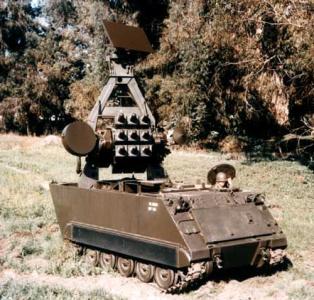General Dynamics MIM-46 Mauler
In the late 1950s, the U.S. Army had a requirement for a new fully mobile FAAD (Forward Area Air Defense) short-range missile system. The name Mauler was assigned to the projected system, and in 1960 a development contract was awarded to General Dynamics, Pomona. Mauler was designed as a quick-reaction semi-active radar homing missile system, where all elements (radar, fire control system, and missiles) were carried by a single tracked vehicle. Test firings of uncontrolled and unguided Mauler LTVs (Launch Test Vehicles) began in September 1961, and were followed in December 1961 by the first launch of a Mauler CTV (Control Test Vehicle), which evaluated the flight characteristics. The first firing of a Mauler GTV (Guidance Test Vehicle), essentially the prototype of the tactical missile, occurred in June 1963. In that same month, the designation XMIM-46A was allocated to the Mauler missile.
The XMIM-46A was launched from an XM546 Tracked Fire Unit, based on the M113 chassis. Each XM546 carried nine missiles in launch canisters in a stacked 3x3 arrangement, the T-I (Tracking and Illumination) CW (continuous wave) radar, and the fire control system. When a threat was detected, the front cap of one missile's container was ejected, and the missile's seeker locked on the target. After launch, its solid-fueled rocket motor accelerated the Mauler to a speed of Mach 3+, and to a range of up to 8 km (5 miles). The target was continuously illuminated by the T-I radar, and the XMIM-46A homed on it using its four tail fins for manoueverability. The blast-fragmentation warhead was exploded by a proximity fuze.
 |
 | |
| Photos: U.S. Army | ||
| XMIM-46A | XM546 Fire Unit | |
The Mauler program was plagued by all kinds of problems from the beginning. These included structural failures of the canisters during launch (thereby damaging adjacent canisters), problems with the new rocket motor (failure of the motor casing), aerodynamic problems (excessive drag and wing flutter), and guidance failures (the seeker lost lock immediately after launch). All these problems led to a reorientation of the Mauler program in November 1963 towards a feasibility demonstration instead of a tactical system development. Tests with XMIM-46A missiles continued through 1965, but the program was finally terminated in November 1965. At that time, various simpler and/or downgraded Mauler configurations had been studied, but even these wouldn't have been ready for deployment before 1969.
In place of the ill-fated Mauler, the U.S. Army developed and procured the MIM-72 Chaparral system, which was based on the proven AIM-9D Sidewinder. In the early 1960s, the U.S. Navy had briefly considered to use a shipborne Mauler variant, the RIM-46A Sea Mauler, as a PDMS (Point Defense Missile System) for surface combat ships. Considering the many problems of Mauler, it is not surprising that the Sea Mauler was never built, the Navy selecting the RIM-7 Sea Sparrow instead.
Specifications
Note: Data given by several sources show slight variations. Figures given below may therefore be inaccurate!
Data for XMIM-46A:
| Length | 1.83 m (6 ft) |
| Wingspan | 33 cm (13 in) |
| Diameter | 12.7 cm (5 in) |
| Weight | 54.5 kg (120 lb) |
| Speed | 1000 m/s (3300 fps) |
| Ceiling | 6000 m (20000 ft) |
| Range | 8 km (5 miles) |
| Propulsion | Lockheed solid-fueled rocket motor; 37 kN (8350 lb) |
| Warhead | 8.6 kg (19 lb) blast-fragmentation |
Main Sources
[1] Bill Gunston: "The Illustrated Encyclopedia of Rockets and Missiles", Salamander Books Ltd, 1979
[2] Redstone Arsenal Historical Information Website
Back to Current Designations Of U.S. Unmanned Military Aerospace Vehicles
Back to Directory of U.S. Military Rockets and Missiles
Last Updated: 15 June 2002